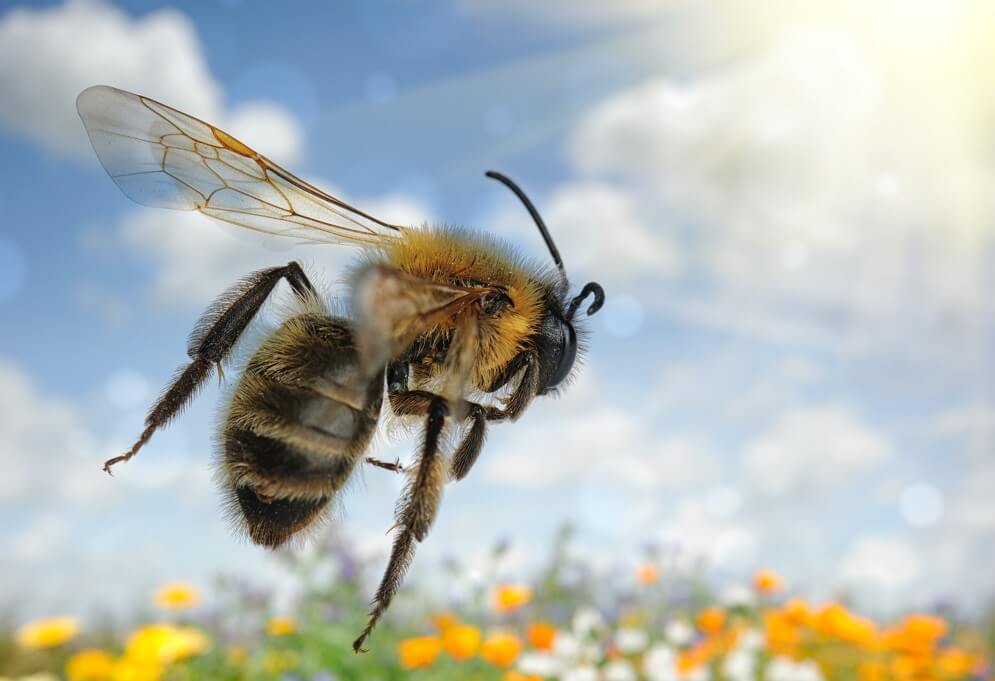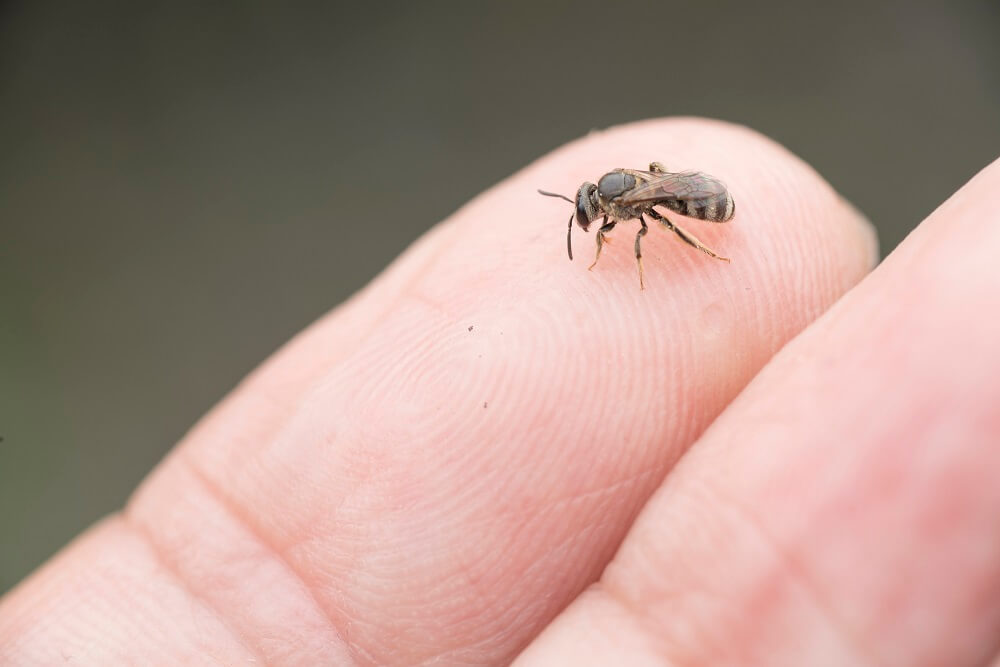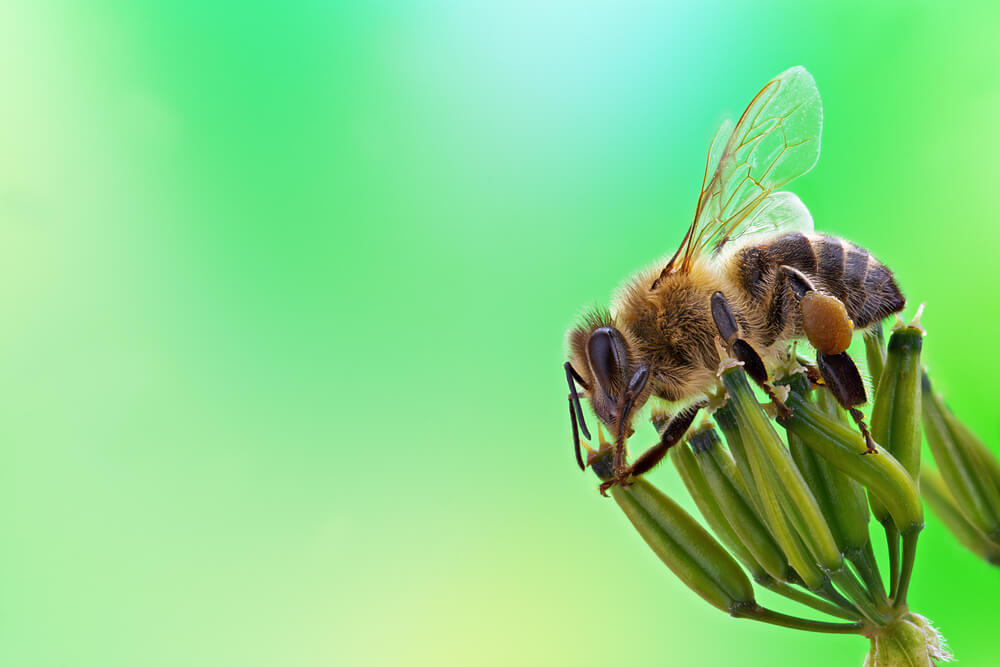Table of Contents:
What’s the Role of the Queen Bee?

The queen honeybee has one very important job:
To help the colony survive.
She makes this happen by laying up to 2,000 eggs per day.
During the warm months, up to 1,000 worker honeybees die per day. Worker bees don’t live nearly as long as the queen, sometimes only living four to six weeks. As such, the queen bee stays focused trying to recoup these losses.
And you know what that means?
The queen is too busy laying eggs to do other things, such as gathering food, building honeycomb, or defending the hive.
Instead, these duties are given to the worker honeybees.
You see, worker honeybees are known as ‘worker bees’ for a reason. Worker honeybees are exclusively female bees, and they do the heavy labor for the colony.
There can be more than 50,000 worker bees in a honeybee colony. Typically, there is only one queen bee per hive.
And while the queen is focused on laying eggs, the worker bees clean, feed, and protect her. Worker bees also care for the baby bees, produce honey, and deter potential predators.
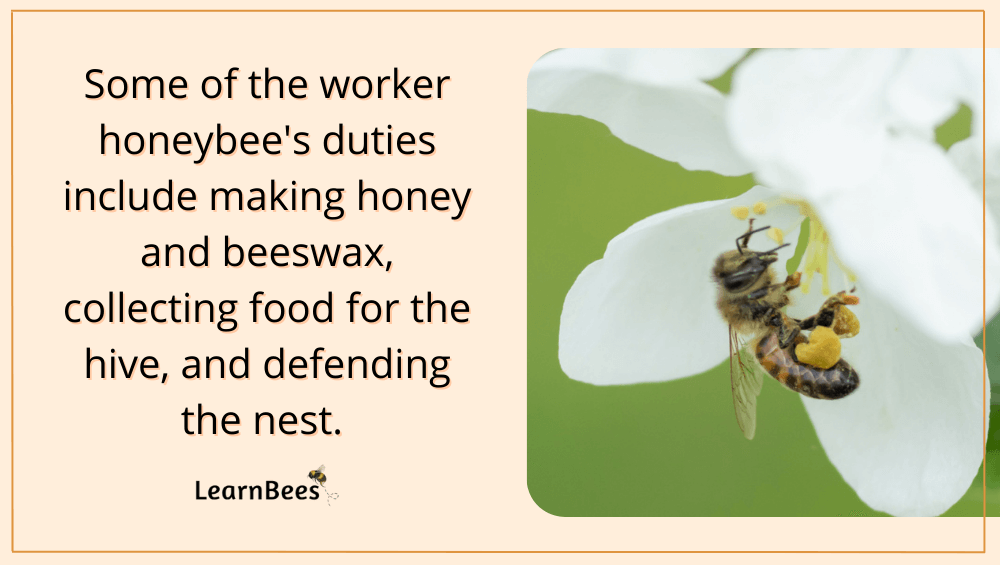
Now here comes the million-dollar question:
Is the queen bee in control of the hive?
Not quite.
It’s tempting to hear the name “queen” and think she’s the supreme leader of the beehive. This isn’t true at all. Instead, honeybee hives work together like a democracy where the worker bees collectively make decisions.
For instance, when the worker bees feel like the queen is underperforming due to her age, they’ll raise a new queen to replace her. And the old queen has no say in the matter.
And after that?
The newly hatched queen has to fight it out with the old queen. They duke it out by stinging each other until one of them dies. The winner claims victory and gets the ‘queen’ title.
So, in summary:
The worker bees supervise the queen honeybee.
Her primary purpose is to lay eggs. The worker honeybees ensure she’s doing her job, and if she isn’t, she gets replaced. It sounds unfortunate, but it’s the natural way of living for honeybee hives.
Is a Queen Bee Born a Queen?
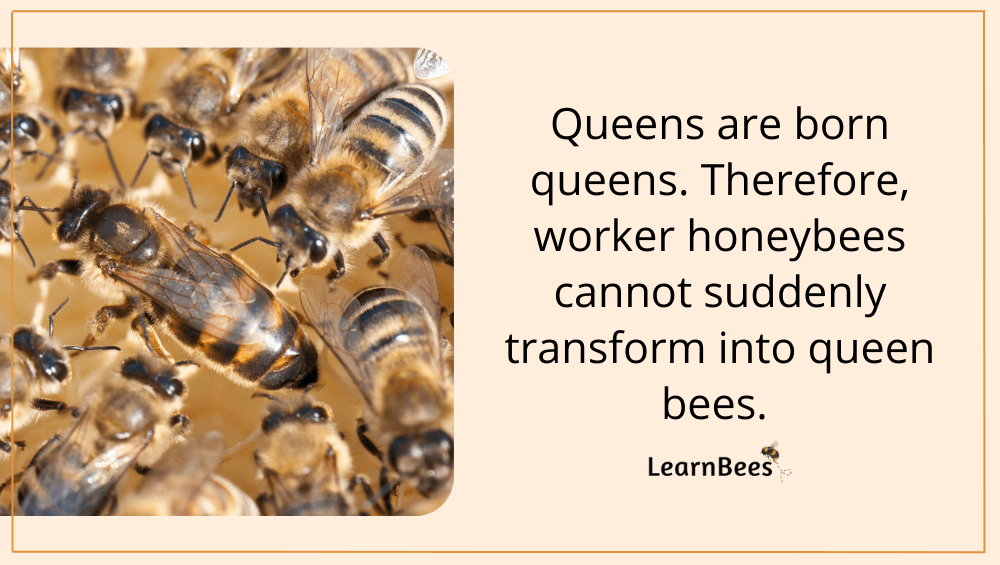
Yes.
Queen bees are born as queens and remain that way their entire lives. It’s the same for worker bees. Workers are born as workers and stay that way.
But this is where people get confused:
Both the worker bees and the queen bee are female.
So, if worker bees are female bees, then why can’t they grow into queens?
Remember:
Honeybee colonies are like well-oiled machines. Each bee has a specially designed role that it was born to fulfill. Worker bees work, queens produce eggs, and male bees mate with queens from other colonies.
Compare this to human society.
Doctors are experts in medicine. Lawyers are experts in the law. Accountants are experts in taxes.
And if a doctor randomly had to start filing taxes, it would be a complete disaster.
Bees are no different.
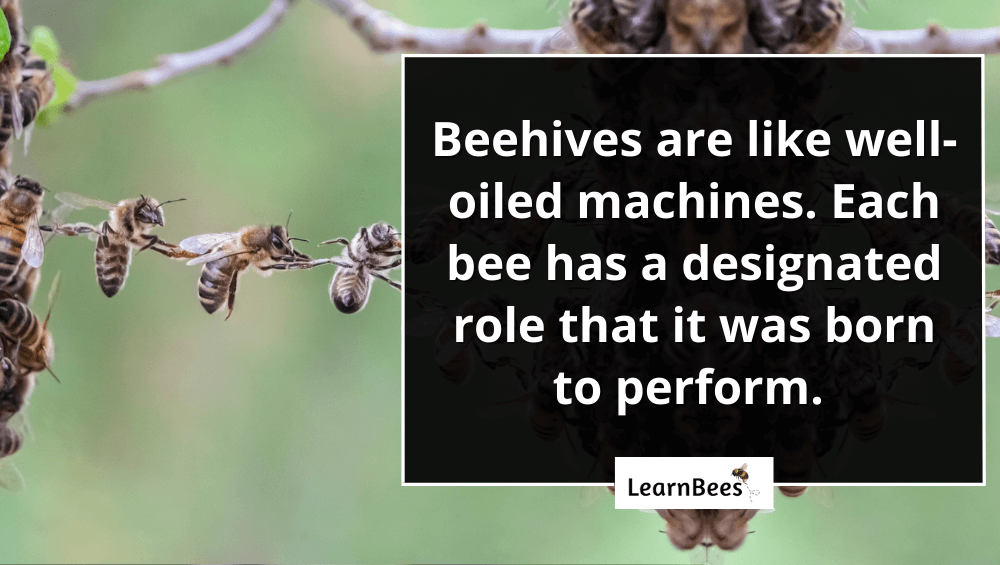
A bee hatches into a queen bee due to the help of the worker bees. Worker bees feed queen larva a special food called “royal jelly.” Royal jelly is highly nutritious compared to the diet given to the worker larvae.
As a result, this special royal jelly diet allows the larva to develop into a fertile queen bee.
Keep in mind:
The queen bee is the only sexually developed female in the hive. With that in mind, she’s the only bee in the colony that mates with male bees.
Worker honeybees, who are also female, can’t lay fertilized eggs because they’re sexually undeveloped. Because of this, worker bees never mate with male bees.
So here’s the thing:
If you notice a honeybee buzzing outside the hive, it’s probably a worker bee.
Queen bees rarely leave the hive because they’re busy laying eggs. This leaves the job of collecting food and water for the worker bees, which is why you’ll see worker bees around flowers.
Will a Queen Bee Sting You?
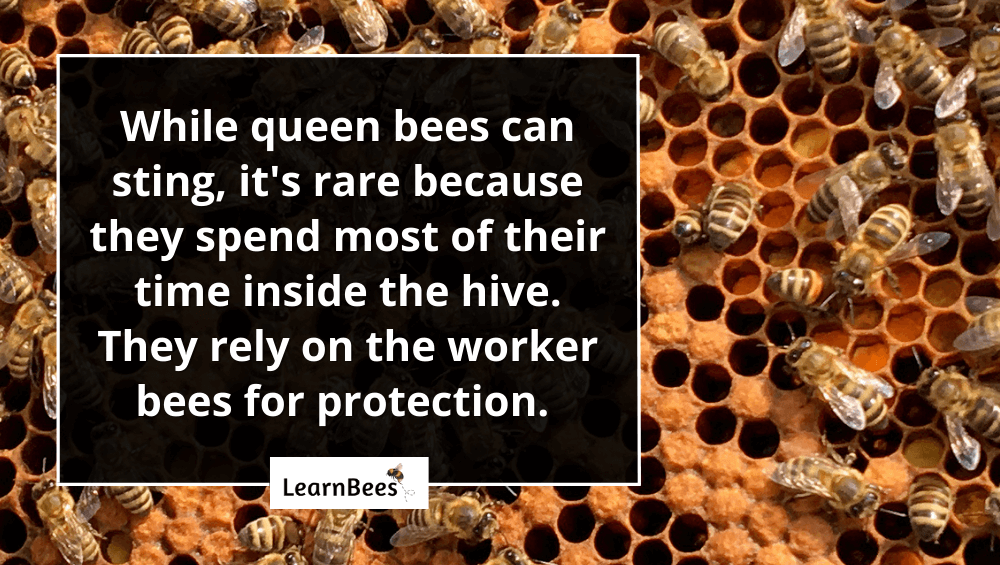
Here’s the thing:
Queen honeybees can sting humans.
But is it likely? Not very.
As mentioned, queen honeybees spend most of their lives inside the hive laying eggs. This means most people have minimal contact with queens because you won’t see them buzzing around flowers like worker bees.
Because let’s face it:
It takes a lot of time and dedication to lay up to 2,000 eggs daily.
This is why the queen bee relies on the worker bees to handle everything else. In fact, the queen honeybee doesn’t even clean herself – the worker bees keep her groomed.
However, the queen bee does have a stinger.
But the purpose of a queen bee’s stinger is to fight off rival queen bees. So if a new queen hatches, the two queens fight until one of them replaces the other.
FAQs on Queen Bees
- Why are queen bees so special?
- Is a queen bee born a queen?
- Will a queen bee sting you?
- Is there a king bee?
- What happens if a queen bee dies?
- How do queen bees get pregnant?
- Can two queen bees live together?
- How long do queen bees live?
- Can a queen bee survive alone?
- How much does a queen bee cost?
- Who mates with the queen bee?
- How long will bees stay in a hive without a queen?
- How many times does the queen bee mate?
- Do queen bees mate with their own drones?
- How long does it take for bees to make a new queen?
- How many queen bees are born?
- Are all bees male except the queen?
- Why would bees not accept a queen?
- How can you tell a virgin queen bee?
- What does a queen bee smell like?
- Does the queen bee leave the hive?
- How many eggs do queen bees lay?
Why are queen bees so special?
Queen bees are special because they are the only female bees in a colony that can mate and lay fertilized eggs.
Worker bees are also female, but they are sexually undeveloped and cannot lay fertilized eggs. And, of course, male bees, or drones, can’t lay eggs.
This means the future of the colony largely depends on the queen bee. She is responsible for populating the hive.
—> Go back to the FAQs on queen bees
More to Explore:
- Do Queen Bees Eat Honey?
- Are Worker Bees Male or Female?
- Queen Bee Versus Worker Bees – How Do They Compare?
Is a queen bee born a queen?
People often ask, “Are queen bees born or created?” and “How does a bee become queen?”
The answer is that queen bees are born queens thanks to the help of worker bees. Worker bees feed queen larva a special food called “royal jelly.” Royal jelly is highly nutritious compared to the diet given to the worker larvae.
As a result, this special royal jelly diet allows the larva to develop into a fertile queen bee.
This also means that worker bees can’t develop into queen bees. They’re born into their roles and will stay that way for the rest of their lives.
—> Go back to the FAQs on queen bees
More to Explore:
- Do Carpenter Bees Pollinate?
- How Long Do Bumble Bees Live?
- Honeybees vs. Bumblebees: How Do They Compare?
Will a queen bee sting you?
Contrary to popular belief, queen bees can sting humans. However, they’re not likely to do so because they spend most of their time inside the hive laying eggs.
Queen bees only sting when they feel threatened. For example, if another queen bee hatches and tries to take over the hive, the two queens will fight until one of them dies.
In short, you’re not likely to be stung by a queen bee unless you’re trying to harm her. And remember, worker bees are the queen’s first line of defense. They protect her at all costs. So you’re more likely to get stung by worker bees than anything else.
—> Go back to the FAQs on queen bees
More to Explore:
Is there a king bee?
No, there is no such thing as a king bee.
There are male bees, but their sole purpose is to mate with queens from other hives. They make no decisions for the colony. In most cases, they simply just mate with little to no responsibilities otherwise.
—> Go back to the FAQs on queen bees
More to Explore:
- Ground Bees: Are They a Threat to Your Yard?
- Wasps vs. Honeybees: Are They Different?
- Do Bumble Bees Bite?
What happens if a queen bee dies?
The queen will be quickly replaced by another queen.
More specifically, the worker bees enter a panic mode where they start feeding larva ‘royal jelly,’ a substance that turns larva into queens.
If worker bees cannot replace the queen, they’ll become a queenless colony that’ll eventually die.
—> Go back to the FAQs on queen bees
More to Explore:
How do queen bees get pregnant?
Like other creatures, queen bees mate so they can lay eggs.
For example, queen honeybees go on ‘mating flights’ where they mate with several drones before returning to the hive.
Mating flights usually happen during spring and summer. After mating, the queen stores the sperm in her body. She’ll use it to lay eggs for the rest of her life.
—> Go back to the FAQs on queen bees
More to Explore:
Can two queen bees live together?
Yes, it can happen in some rare cases, but it’s usually temporary – only lasting a few weeks or months. Most of the time, there is only one queen bee per hive.
—> Go back to the FAQs on queen bees
More to Explore:
How long do queen bees live?
Queen honeybees can live two to four years, on average.
This is much longer than worker bees, which only live for about six weeks during the summer.
—> Go back to the FAQs on queen bees
More to Explore:
Can a queen bee survive alone?
No, the queen honeybee needs worker bees to survive.
The worker bees take care of the queen and do all the work in the hive – from collecting food to building honeycombs. Without worker bees, the queen wouldn’t have anything to eat and would eventually die.
The same is true for worker bees. They need their queen to ensure the colony as a whole can survive.
—> Go back to the FAQs on queen bees
More to Explore:
How much does a queen bee cost?
The price of a queen bee varies depending on the type of bee and where you buy it. An average cost of a queen bee is $25 – $40.
—> Go back to the FAQs on queen bees
More to Explore:
Who mates with the queen bee?
Drone bees (males) from other colonies will mate with the queen bee. Drones will leave the nests to search for queen bees from other hives.
—> Go back to the FAQs on queen bees
More to Explore:
How long will bees stay in a hive without a queen?
The colony will not be able to survive more than a couple of weeks or months without a queen. This is why they try to quickly replace her if she dies.
—> Go back to the FAQs on queen bees
More to Explore:
How many times does the queen bee mate?
The queen honeybee mates during a one to two week period after she hatches. During these few weeks, she goes on ‘mating flights’ where she mates with 12-30 drone bees.
—> Go back to the FAQs on queen bees
More to Explore:
Do queen bees mate with their own drones?
No. Drones mate with queens from other hives. So most queens mate with drones from neighboring hives or wild honeybee hives.
However, recessive genes due to inbreeding can happen in all living creatures that reproduce sexually. However, the nature of the way bees live typically results in a very low chance of excessive inbreeding.
—> Go back to the FAQs on queen bees
More to Explore:
How long does it take for bees to make a new queen?
The honeybees start the process of making a new queen within 24 hours of losing their old queen. But the process takes about 16 days for the new queen to hatch from start to finish.
—> Go back to the FAQs on queen bees
More to Explore:
How many queen bees are born?
Several queens can hatch at once, but they’ll fight each other until one wins and takes the reign as the sole queen bee.
—> Go back to the FAQs on queen bees
More to Explore:
Are all bees male except the queen?
No, most bees in a colony are worker bees. Worker bees are exclusively female. Male bees (drones) only make up a small portion of the colony.
Large amounts of male bees aren’t needed because they don’t work like worker bees do. Instead, their sole job is mostly to mate with queens from other hives.
—> Go back to the FAQs on queen bees
More to Explore:
Why would bees not accept a queen?
Worker bees will not accept the queen if they aren’t happy with her. A few reasons for this include:
- She isn’t producing enough eggs
- Her pheromones have diminished
- The hive is under stress
- Something is wrong with the queen’s brood
- She’s hurt or damaged
- She’s a new queen they aren’t used to (such as an external queen being introduced to a hive by a beekeeper)
—> Go back to the FAQs on queen bees
More to Explore:
How can you tell a virgin queen bee?
Virgin queens are typically smaller in size (with smaller abdomens) because they haven’t mated yet.
After successfully mating and laying eggs for about a week, her abdomen becomes more plump and elongated. You’ll notice that her abdomen will be much longer than her wings’ length (sometimes twice the length).
—> Go back to the FAQs on queen bees
More to Explore:
What does a queen bee smell like?
Queen bees produce special pheromones that the worker bees can detect. However, the queen bee doesn’t have a unique fragrance that humans can use to find her. Beekeepers mostly rely on their vision to spot queen bees during hive inspections.
—> Go back to the FAQs on queen bees
More to Explore:
Does the queen bee leave the hive?
Queen honeybees will leave the hive after hatching to go on ‘mating flights.’ Once they return home, they typically stay inside the hive because they’re busy laying eggs. Worker bees are the ones that venture outside of the hive to collect food and water.
If the hive becomes overcrowded, the queen bee will leave with half the colony to find a new home. This process is known as swarming.
—> Go back to the FAQs on queen bees
How many eggs do queen bees lay?
A healthy queen can lay up to 2,000 eggs per day during the spring and summer. This number starts to decline as winter approaches.
